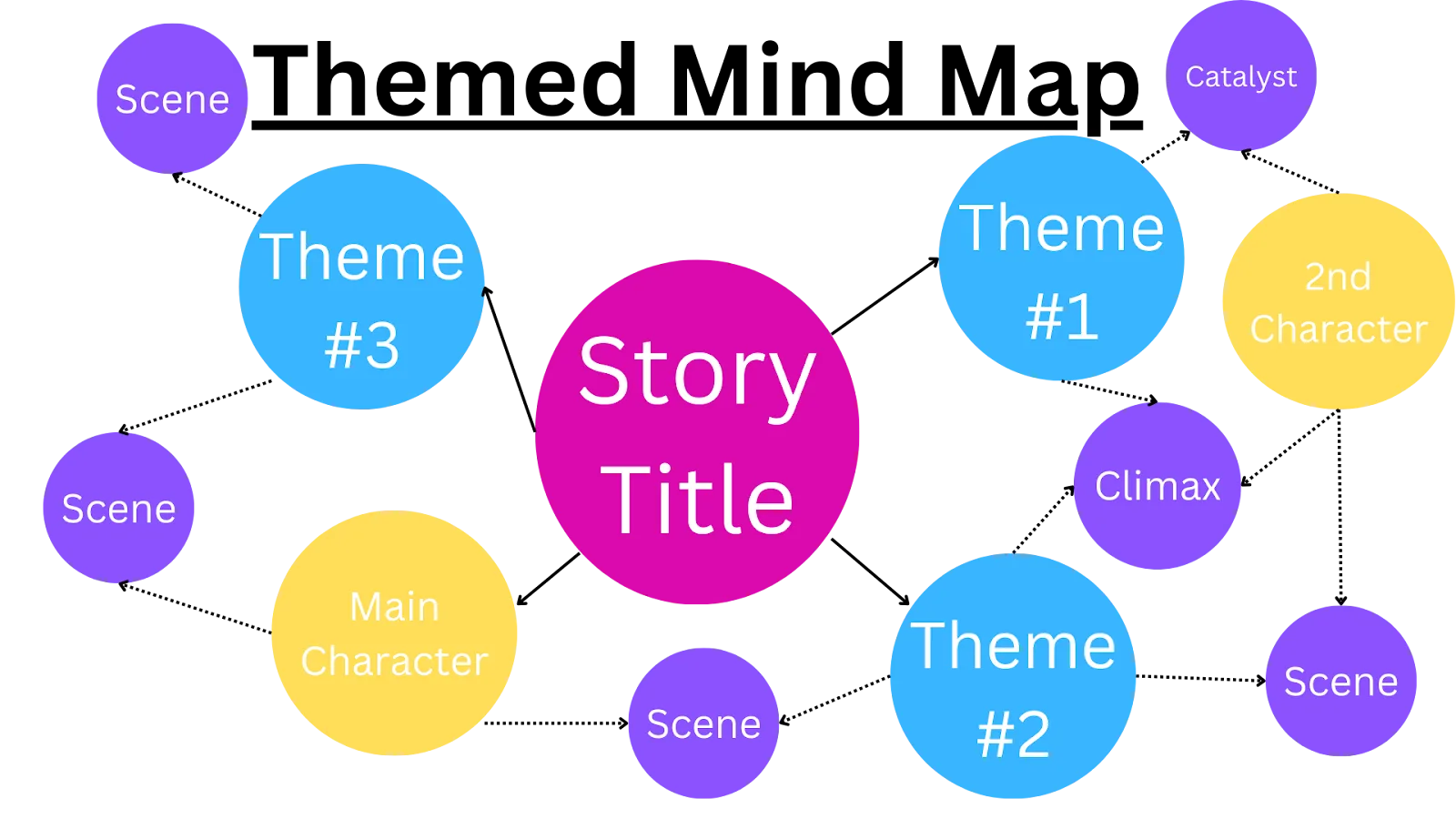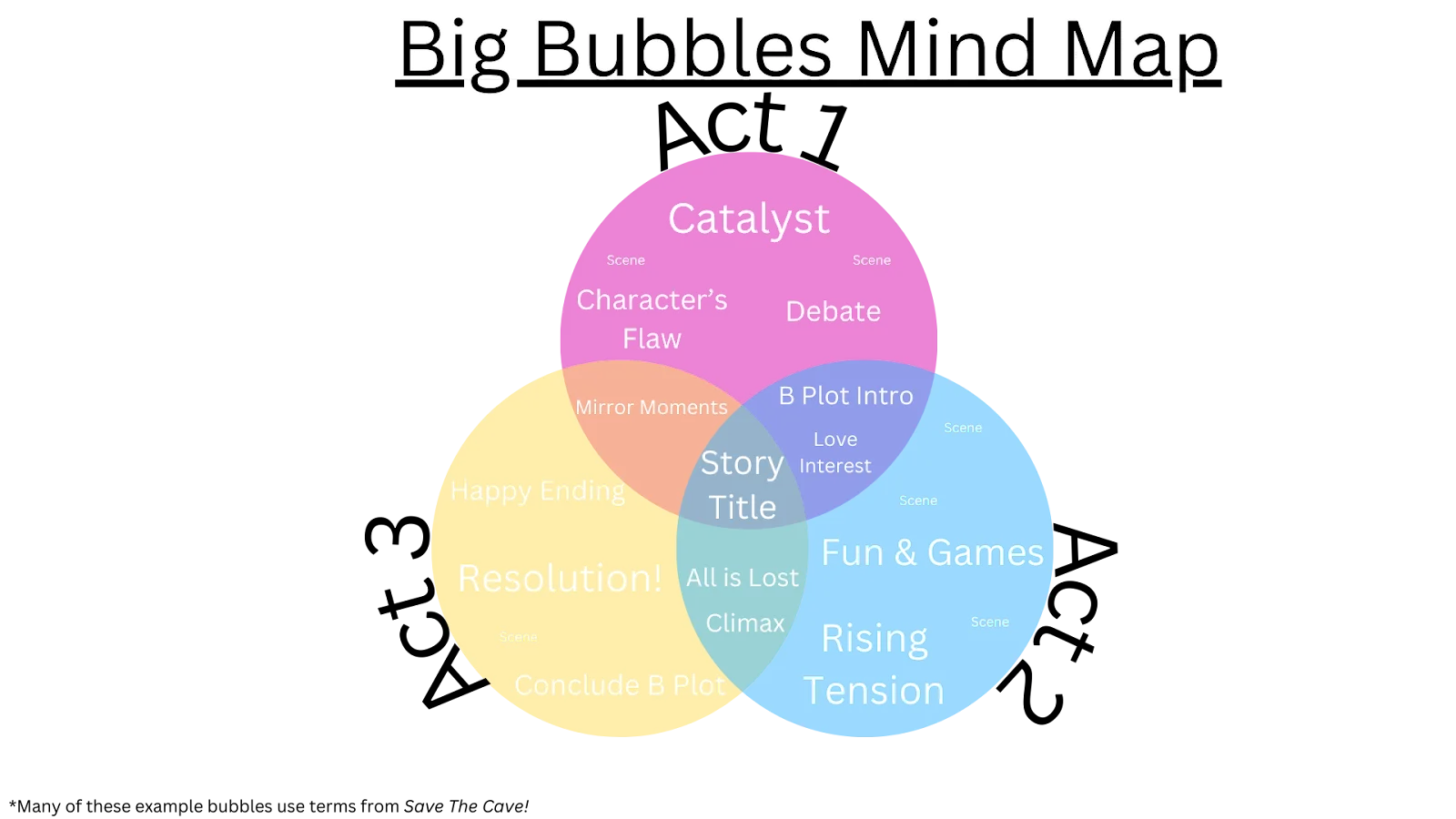How To Outline A Story With Mindmaps | Visual Novel Planning
Ollie Ander
Is probably just a couple cats in a trench-coat—the hair shedding and sunlight napping are highly suspect.
There’s an overwhelming amount of $ novel outlining methods$ to choose from out there: Three Act Structure, $ Save the Cat!$ , the $ Snowflake Method$ , the Seven-point Story Structure, and on and on it goes.
If you’ve never used an outlining method before, it may take some trial and error to find one that works for you…but what if there was a way to outline that always works? Made for you, by you: Mind Mapping.
Use Mind Mapping to get your ideas down so they’re easier to deal with, find the patterns in your story, and eventually, you’ll be able to morph those random bits of information into a notable structure!
Every Mind Map is different by nature, but they can lend to plotting your novel into another, more formulaic method, once everything has been broken down and your story’s prominent elements have been identified.

What is a Mind Map?
A Mind Map is a brainstorming method used to visually represent one’s process of thought; a concept, or in our case, a story.
Mind Maps are an organic expression of branching bubbles and lines, with no rules whatsoever.
You should try and keep it coherent, but if your first Mind Map is chaotic beyond understanding, that can also be a good thing—at least you’ve got the thoughts out!
You can always refine your Mind Map with further iterations, narrowing in on what’s important and how those ideas connect.
How Can a Mind Map Help with Outlining a Story?
Viewing your story visually is always helpful, no matter the method.
Mind Maps are as variable as the mind that creates them, so it’s hard to say exactly how yours will look and how best to shape it into a narrative structure.
However, I have come up with three examples of Mind Maps for a story to show how they can serve as a reference during the writing process, and how to input your Mind Map into a more conventional story outline.
Example 1: Themed Mind Map
This is the most organic sort of Mind Map. There doesn’t need to be a particular rhyme or reason to the branches off of the center, but it is helpful to limit yourself to a story element.
For example, all the main branches could be the ongoing themes, which you can then branch further into which scenes will display the given theme, or which characters exemplify them, fleshing out their natural connection.

Alternatively, you may wish to branch off the main title with your main characters, connect them as you can through scenes in which they interact to get a better look at the web of relationships.
You can make as many Mind Maps for a project as you like, each focused on something different.
Example 2: Plug and Play Mind Map
This Mind Map is focused on writing down the prominent moments you know you want to have in your story, even if you’re not quite sure how to get there yet.
They might not be able to fit into another outlining method in its first iteration, but you can always re-shape what you’ve written down, after the fact—trim or add bubbles.

Aside from a few extra nodes sprinkled in, you may just be able to tweak and broadly brush over your Mind Map to fit, say, The Three Act Structure.
Even just color coding bubbles of a particular type could be helpful in visualizing where your story is strongest, and what might need more attention.

Example 3: Big Bubbles Mind Map
You don’t have to treat your Mind Map like a tree—it could be an ocean. My preferred Mind Map is actually a Venn Diagram.
The working title of the novel goes in the middle, the Three Acts are the main circles, and the little spaces where they intersect house all the plot points that transition them.

For example, Act 2 and Act 3’s overlap could have the "All is Lost" scene. Since the whole narrative isn’t technically circular, the overlap of Act 3 and Act 1 can house the "Mirror Moment" where the opening image of the main character is reflected at the very end, but changed.
The Acts themselves are just a smattering of scenes that happen within them so Act 2 will be full of the "Fun & Games."
Of course, everything is entirely up to your preference and design. Mind Mapping might be a free-for-all but it’s a great way to get your thoughts down to discern a narrative direction, and playing around with interconnecting elements may help you discover themes you’d never even noticed before!
If you like the idea of branching out your story bit by bit, but want a little more guidance, $ The Snowflake Method $ might just be the outlining strategy for you!
Like what you're reading?
Join other authors like you in NovelPad’s free writing community!
Join the communitySimilar Posts
What File Formats are Accepted by Kindle Direct Publishing?
File types for ebooks, paperbacks, and hardbacks on Amazon's KDP.
Ollie Ander
Is probably just a couple cats in a trench-coat—the hair shedding and sunlight napping are highly suspect.
The Writer’s Resolution Guide 2024
Goal ideas and strategies for your new writing year.
Sage Kay
Writer, reader, outfit repeater.
When is the best time to publish a romance novel?
What is the best month and day of the week to publish a romance? Do romance novelists make money?
Rina Fontes Malka
A writer with too many ideas and not enough time.
When is the best time to publish a self-help book?
Are self-help books wanted year-round, or is there a more strategic approach to publishing?
S.R. Beaston
Crafty with words, wit, and wisdom, just add caffeine to make it more interesting.
When is the best time to publish a fantasy novel?
Strategies for when to publish your fantasy novel; best month; best day of the week.
S.R. Beaston
Crafty with words, wit, and wisdom, just add caffeine to make it more interesting.
When is the best time to publish a horror novel? [Peak Sales Method]
Make the most of your horror book launch by strategizing with these tips.
Bella Rose Emmorey
book editor, rogue behaviorist, digital marketer, writer, brand builder, plant aunt, and cheese enthusiast.